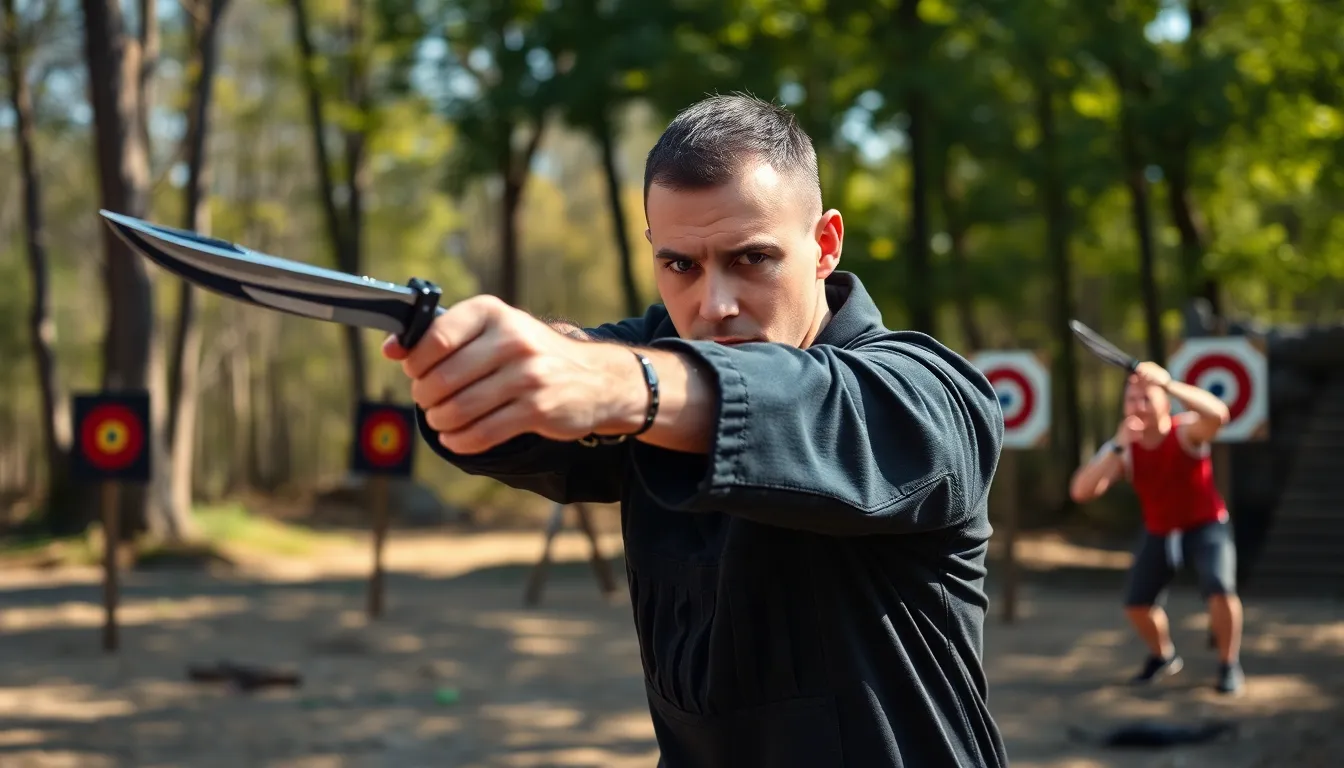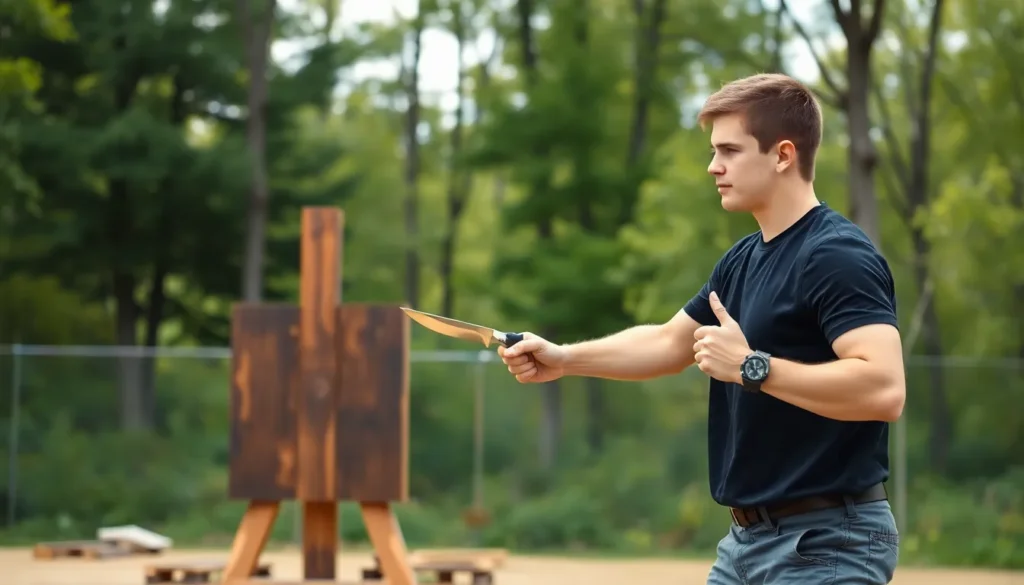Table of Contents
ToggleIn a world where precision meets adrenaline, throwing knives have carved out a niche that’s both thrilling and deadly. Imagine the rush of launching a blade with the finesse of a seasoned assassin or a circus performer gone rogue. It’s not just about the throw; it’s about the art of the kill, and it’s a lot more entertaining than your average game of darts.
From ancient warriors to modern-day enthusiasts, the allure of throwing knives is undeniable. Whether it’s for self-defense, sport, or a dramatic flair in a movie scene, these sharp projectiles have a way of captivating audiences. So grab your favorite blade and get ready to explore the fascinating world of throwing knife kills, where every throw counts and the stakes are higher than ever. Who knew a little metal could pack such a punch?
Overview of Throwing Knife Kills
Throwing knife kills feature in various contexts, often showcasing precision and skill. The art of throwing knives dates back to ancient times when warriors employed them in combat, emphasizing their lethality. Modern enthusiasts embrace this practice for sport and self-defense, recognizing the technique’s importance for achieving accuracy.
Competitions often highlight the skills required to hit targets accurately. Competitors hone their abilities through practice, aiming for bullseyes, and aiming to unleash the knife with optimal speed and trajectory. Achievements in throwing knife competitions can range from beginner to expert levels, with many participating in local and international events.
In films and video games, throwing knives add an element of drama and excitement. These mediums portray characters who master throwing knives, creating a connection between cinematic storytelling and real-life skills. Such representations inspire many to learn the art, enhancing the popularity of throwing knife kills within martial arts and recreational settings.
Mental focus plays a crucial role in achieving successful throws. Each throw presents an opportunity to refine technique and develop a deeper understanding of balance and body mechanics. Onlookers often witness impressive displays of skill, further increasing interest and participation in the sport.
Self-defense practices also utilize throwing knives effectively. When confronted with an assailant, individuals trained in this discipline can respond quickly and decisively. In these scenarios, the combination of speed, precision, and distance becomes vital for survival.
Overall, throwing knife kills offer a unique blend of challenge, entertainment, and practicality. This captivating realm appeals to a diverse audience, drawing both practitioners and spectators into the world of throwing knives.
Historical Context

Throwing knives have a rich history that spans various cultures and time periods. Their uses evolved beyond mere weaponry to encompass sport, art, and self-defense.
Ancient Uses of Throwing Knives
Ancient warriors utilized throwing knives as practical weapons in battles. Different cultures, such as the Egyptians and Aztecs, incorporated these blades for ranged attacks. Some societies employed throwing knives for hunting, showcasing skills crucial for survival. The design of these weapons varied, with some crafted for balance and others tailored for lethal precision. Despite technology advancements, the essence of throwing knives as tools of combat remained significant.
Modern Applications in Combat
Modern combat scenarios exhibit the continued relevance of throwing knives. Military personnel and special forces incorporate them into tactical training. Various martial arts disciplines embrace throwing techniques, focusing on accuracy and technique. Training programs now emphasize mental focus alongside physical skill, enhancing overall combat readiness. Many practitioners appreciate the blend of tradition and innovation, recognizing the effectiveness of throwing knives in specialized situations.
Techniques for Effective Throwing Knife Kills
Mastering throwing knife kills involves specific techniques focused on grip, stance, and mechanics. Precision relies heavily on these foundational skills for effective performance.
Grip and Stance
Correct grip and stance maximize control during throws. Fingers should curl around the handle, allowing for a firm yet relaxed grip. The position of the thumb plays a critical part in stability, as it provides guidance during the throw. Feet should be shoulder-width apart, with the dominant foot slightly forward to enhance balance. Knees need to remain slightly bent, adding to the overall stability. Engaging the core ensures proper weight distribution, which promotes fluid motion when releasing the knife. Practicing different grip styles helps identify personal preferences for optimal performance.
Aiming and Throwing Mechanics
Aiming requires a keen focus on the target and deliberate alignment. Eyes should lock onto the target, establishing a straight line from the throwing arm to the bullseye. Variability in distances calls for adjustments in throwing mechanics. Arm movement starts from the shoulder, flowing through the elbow and wrist for maximum power and precision. The release point is crucial; it should occur when the knife is level with the target. Follow-through contributes to accuracy, ensuring the knife maintains a straight trajectory. Repeated practice hones both aiming and throwing techniques, leading to consistent results.
Notable Incidents Involving Throwing Knife Kills
This section covers significant events related to throwing knife kills, highlighting their historical and contemporary relevance.
Famous Cases in History
Throughout history, throwing knives have made their mark in various notable incidents. One such case occurred during World War II when soldiers utilized knives for silent takedowns. Roman gladiators also incorporated throwing weapons during combat, using them to gain an advantage in arena battles. In both the American West and Caribbean piracy, famous figures have sometimes employed throwing knives as a means of intimidation or lethal force. These historical examples reflect the effectiveness and allure of throwing knives as weapons through time.
Recent Events and Their Impact
Recent incidents involving throwing knives have sparked discussions about safety and self-defense. In 2022, an altercation in a major city led to injuries from a throwing knife, prompting local governments to consider regulations. Increased media coverage has focused on knife-related crimes, influencing public perception of knife use. Martial arts competitions featuring throwing knives have also gained popularity, inspiring new enthusiasts to explore this skill. These events underline the importance of responsible usage while promoting the sport’s captivating aspects.
Ethical Considerations
Ethical implications surround the act of throwing knife kills. Discussions about violence in sports emphasize the importance of safety and regulation. Responsible use of throwing knives requires understanding their historical context as both tools and weapons. Practitioners must consider the impact of demonstrating knife skills publicly, especially regarding potential harm.
Regulations vary by region, with some areas instituting restrictions on carrying and using throwing knives. An awareness of local laws helps ensure compliance and promotes responsible practice. The use of knives in self-defense scenarios invokes deeper ethical questions, including when and how self-defense justifies lethal force.
Emphasis on training in controlled environments enhances safety for both participants and spectators. Competitions encourage a focus on skill rather than aggression, fostering a respectful environment among practitioners. Insight into the psychological effects of using knives for harm highlights the necessity of mental preparedness and emotional control.
Debates continue regarding whether cinematic portrayals of knife throwing glamorize violence. Educators and enthusiasts alike advocate for responsible teaching methods that stress ethical behavior. Sharing knowledge about the risks associated with throwing knives provides a balanced understanding of their uses.
Difficult conversations about the societal implications of knife skills encourage responsible practices. A commitment to ethical considerations promotes a safer environment for all involved in the throwing knife community. A focus on respect, safety, and education remains vital as the popularity of throwing knives continues to grow.
The world of throwing knife kills offers a unique blend of skill and excitement that captivates both enthusiasts and spectators. As practitioners hone their techniques and engage in competitions, they not only embrace a thrilling sport but also connect with a rich historical legacy. Understanding the importance of safety and ethical practices is essential for fostering a respectful environment in this captivating discipline.
Ultimately, throwing knives represent more than just a means of entertainment; they embody a commitment to precision and discipline. With the right training and mindset, individuals can appreciate the artistry involved while navigating the responsibilities that come with wielding such a potent skill.




